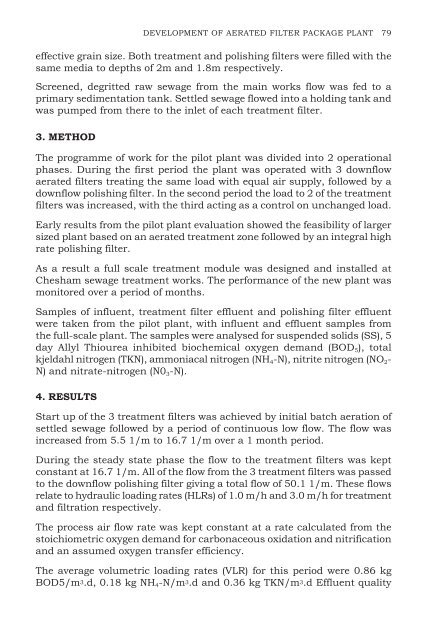Advances in Water Treatment and Enviromental Management
Advances in Water Treatment and Enviromental Management
Advances in Water Treatment and Enviromental Management
Create successful ePaper yourself
Turn your PDF publications into a flip-book with our unique Google optimized e-Paper software.
DEVELOPMENT OF AERATED FILTER PACKAGE PLANT 79effective gra<strong>in</strong> size. Both treatment <strong>and</strong> polish<strong>in</strong>g filters were filled with thesame media to depths of 2m <strong>and</strong> 1.8m respectively.Screened, degritted raw sewage from the ma<strong>in</strong> works flow was fed to aprimary sedimentation tank. Settled sewage flowed <strong>in</strong>to a hold<strong>in</strong>g tank <strong>and</strong>was pumped from there to the <strong>in</strong>let of each treatment filter.3. METHODThe programme of work for the pilot plant was divided <strong>in</strong>to 2 operationalphases. Dur<strong>in</strong>g the first period the plant was operated with 3 downflowaerated filters treat<strong>in</strong>g the same load with equal air supply, followed by adownflow polish<strong>in</strong>g filter. In the second period the load to 2 of the treatmentfilters was <strong>in</strong>creased, with the third act<strong>in</strong>g as a control on unchanged load.Early results from the pilot plant evaluation showed the feasibility of largersized plant based on an aerated treatment zone followed by an <strong>in</strong>tegral highrate polish<strong>in</strong>g filter.As a result a full scale treatment module was designed <strong>and</strong> <strong>in</strong>stalled atChesham sewage treatment works. The performance of the new plant wasmonitored over a period of months.Samples of <strong>in</strong>fluent, treatment filter effluent <strong>and</strong> polish<strong>in</strong>g filter effluentwere taken from the pilot plant, with <strong>in</strong>fluent <strong>and</strong> effluent samples fromthe full-scale plant. The samples were analysed for suspended solids (SS), 5day Allyl Thiourea <strong>in</strong>hibited biochemical oxygen dem<strong>and</strong> (BOD 5 ), totalkjeldahl nitrogen (TKN), ammoniacal nitrogen (NH 4 -N), nitrite nitrogen (NO 2 -N) <strong>and</strong> nitrate-nitrogen (N0 3 -N).4. RESULTSStart up of the 3 treatment filters was achieved by <strong>in</strong>itial batch aeration ofsettled sewage followed by a period of cont<strong>in</strong>uous low flow. The flow was<strong>in</strong>creased from 5.5 1/m to 16.7 1/m over a 1 month period.Dur<strong>in</strong>g the steady state phase the flow to the treatment filters was keptconstant at 16.7 1/m. All of the flow from the 3 treatment filters was passedto the downflow polish<strong>in</strong>g filter giv<strong>in</strong>g a total flow of 50.1 1/m. These flowsrelate to hydraulic load<strong>in</strong>g rates (HLRs) of 1.0 m/h <strong>and</strong> 3.0 m/h for treatment<strong>and</strong> filtration respectively.The process air flow rate was kept constant at a rate calculated from thestoichiometric oxygen dem<strong>and</strong> for carbonaceous oxidation <strong>and</strong> nitrification<strong>and</strong> an assumed oxygen transfer efficiency.The average volumetric load<strong>in</strong>g rates (VLR) for this period were 0.86 kgBOD5/m 3 .d, 0.18 kg NH 4 -N/m 3 .d <strong>and</strong> 0.36 kg TKN/m 3 .d Effluent quality
















